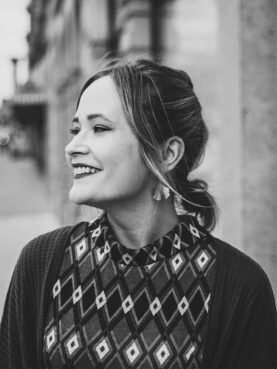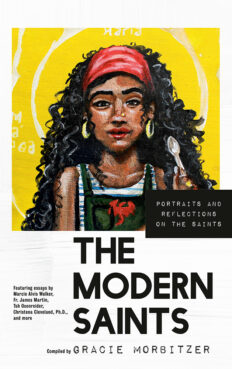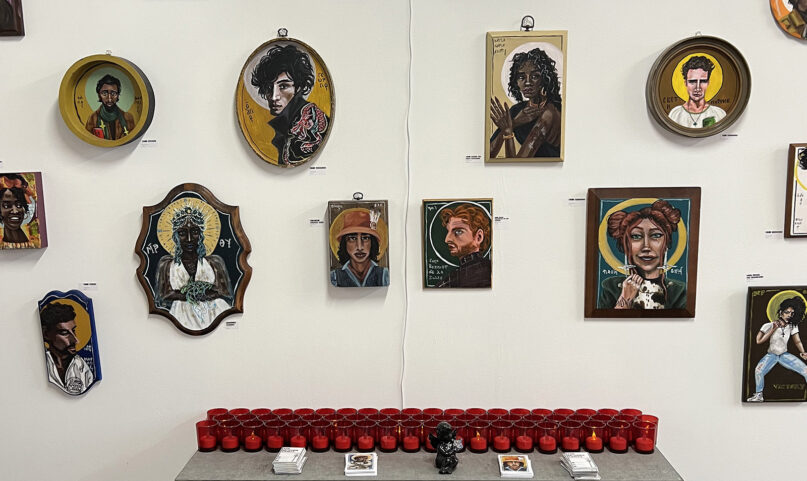(RNS) — As Christians across the world dig out their Nativity sets for Advent, countless figurines of Mary, mother of Jesus, will be on display. Whether part of a classic wood carved set, the kid-friendly Fisher-Price model or a plastic outdoor collection, most of these Marian depictions involve a slim woman with a blue robe, downcast gaze and unmistakably white skin.
But in her new illustrated book, “The Modern Saints,” artist and editor Gracie Morbitzer offers eight images of Mary among her collection of 52 saints that challenge this docile, white-washed image.
There’s Mary as The New Eve, a pregnant mother with glistening Black skin, a snakeskin in her pocket and flowers adorning her afro. Mary in the icon “Madonna and Child” has a nose piercing, ripped jeans and tattoo of her immaculate heart as she nestles a swaddled Jesus. Mary as Our Lady of Guadalupe is depicted with a short skirt, flower crown and converse-clad feet crushing a serpentine border wall.
These striking and occasionally provocative renderings of Mary are emblematic of Morbitzer’s “Modern Saints,” a project intended to show that the saints, while holy, were also deeply human.

Gracie Morbitzer. (Courtesy photo)
What began as a side project and gained traction through Morbitzer’s viral Modern Saints Instagram account is now taking on new meaning in book form. For the book, Morbitzer is pairing 52 of her modern icons — out of the 150 she’s created so far — each with an artist statement, a summary of the saint’s life, a devotional reflection and a prayer. The reflections are written by 50 authors Morbitzer calls the “saints of tomorrow,” including Jesuit priest James Martin, “Gay & Catholic” author Eve Tushnet, public theologian Christena Cleveland and author D.L. Mayfield.
Religion News Service spoke with Morbitzer about her forthcoming book, which includes 20 never-before-seen portraits and is scheduled to be published by Convergent Books on Dec. 5. This interview has been edited for length and clarity.
What do you mean when you call the saints some of the original social justice warriors?
I think that for a lot of the saints, we know them for their writings on the faith. But they really did so much in their communities. A lot of them created the first social services in their area, making hospitals and orphanages. If they were born into nobility or wealth, they gave away their possessions to be with the suffering members of their community and to try and lift them up. And many who weren’t able to directly interact with others, such as cloistered monks or nuns, wrote letters or spoke out to politicians or governments about how they believed the world should be according to Jesus’ messages. Most of the time this was fighting for social justice. And those are the things we’re called to do as well.
Why did you choose St. Martha as the cover?
Martha is described as very busy and stressed by her work. And yet she’s not the one who is praised by Jesus for what she’s doing. But she has a change of heart, halfway through her story. With the second mentioning of her (in John’s Gospel), she is the one to first acknowledge Jesus for who he is, and she leaves behind other expectations that others may have had for her. I think the reflection about her that was written by Shannon Schmidt in the book can really relate to a lot of the readers. There are a lot of ways we can interpret the story of Martha, but the one I like best is to spend time on what really matters, with who really matters, and not to let what we think we should be doing to get in the way.
It can be easy to get caught up in painting what might be on trend, or what might be expected of me in this work. So focusing on the story of Martha can be a good reminder not to do that.
Why begin the book with a land acknowledgment?
I wanted to address the violence and colonization and wrongs that the church in general has done throughout the years, all over the world. With all of these saints being portrayed as heroes and role models, I wanted to make sure we can all remember they were still human beings. And there were many people in the church who caused harm.
What are the biggest ways your faith has shifted since you began creating these icons?

“The Modern Saints” by Gracie Morbitzer. (Courtesy image)
When I first started this project, I was still in school. I had just gone to Columbus College of Art and Design, but my whole life up to that point I had been in Catholic school, in really traditional, dogma-based religion classes. When I got to college, I met so many people who were hurt by Christianity or who were really great people, even though they didn’t have any faith tradition. Some of the ideas I had formed up to that point about Christianity started to change.
When I started this painting project, I felt like I was the only person out there who felt this way about my faith. The community I started finding, who are a lot of these writers and authors and people who wrote reflections for this book, proved to me that’s not true.
By showing everyone how the saints really may have looked, and how they might look if they were living today, I hope people who are still really involved in more traditional Christianity might be able to challenge their preconceived notions about what a holy person looks like. And for the people outside the faith who had been hurt, being able to see themselves as a saint may provide some healing or let them know they’re not alone in their struggles. With the book, all of these different experiences of Christianity the authors write about prove there’s not just one way to live as a Christian. And that’s what the saints show us, too.
Is there a saint you’ve gravitated toward during the creation of this book?
St. Hildegard of Bingen has been one of my favorite saints in this process. She was always really interested in creating, and of course as an artist and writer that is something I gravitate toward. She not only wrote and painted, but she also created operas and plays and music, and then studied science and healing and gardened. Even though she was supposed to be a cloistered nun, she wrote letters to people in politics and went on speaking tours. And this was the Middle Ages. People listened to her ideas and she made a lot of change in her time. She didn’t let anything about her society or traditions stop her.
Why do you think the saints seem to be resonating with folks right now?
A lot of American Christianity seems to tell only one story about the faith and what it can be. And people are getting tired of that and are realizing how much harm it’s caused. In the saints, you can find every different idea within the faith that’s possible. Some of them directly disagreed with one another. So to be able to know there’s someone who is revered within the faith who has the idea that you have, or who fought for the thing you want to fight for, can be really great for hope. The saints were so diverse in their ideas, where they lived in the world, their skills and their talents. These are the people the church wants to raise up. That can be so liberating for anyone who has felt like an outcast.





